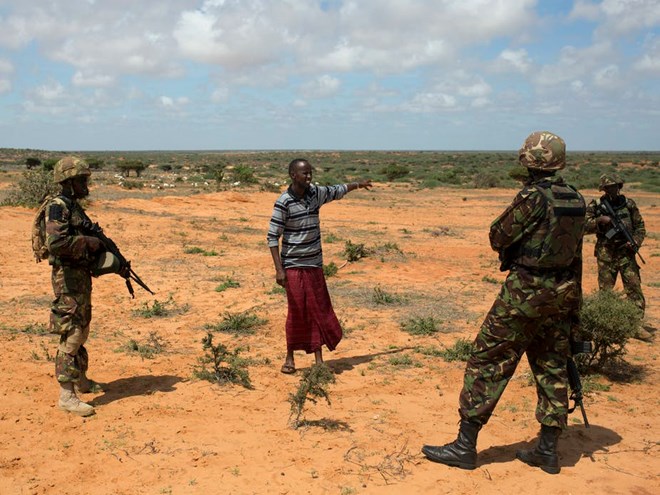On 16 October 2011, Kenyan troops crossed the border into Somalia. The official reason was that Kenya’s national security was threatened by the Somalia-based Islamist militant group, Al-Shabaab. The terrorist group had in fact carried out a number of cross-border raids during the months preceding the operation.
There’s still considerable disagreement about the reasons for Kenya’s military action in October 2011.
More than six years after Nairobi made the drastic move, Kenyan troops are still in Somalia and Al-Shabaab is still considered a threat to Kenya. Numerous terrorist attacks have been carried out by the Somali group, including the deadly siege on the Westgate shopping mall in 2013.
There are a number of possible explanations as to why the Kenyan authorities made the decision to engage Al-Shabaab in Somalia. These range from trying to prop up the Kenyan army’s image, to currying favour with the West, to making the north east of the country safer. Some strategies have proved more successful than others.
Proving a point
One possible explanation for the action is that the Kenyan Defence Force was eager to show that it could actually fight a war. In the run up to the action, the Kenyan military had been stung by Ugandan President Yoweri Museveni’s mocking remark that it was a “career army” ill-equipped to face a guerrilla insurgency.
Added to this were Kenyan concerns about Uganda’s growing military footprint in Somalia which could threaten the self-perception of the KDF as a superior military power in East Africa. So crossing the border deploying troops in Somalia was part of an exercise to enhance the image of the KDF in the eyes of the population in the midst of allegations of corruption.
Some reports have also suggested that some senior officers expected that the Kenyan troops committed to Somalia could eventually join the African Union Mission in Somalia. The countries contributing to the mission at the time were Uganda, Burundi and Djibouti.
The integration of Kenya into the mission would have meant that some, if not all, of the costs of the military action would be funded by international donors. In these Kenyan officers’ calculation, joining the mission would mean the government would have to find less from the national budget.
Combined, these factors gave the Kenyan army a strong institutional interest in crossing over into Somalia.
The Somali connection
Nevertheless, the then Kenyan president Mwai Kibaki appeared initially to have been hesitant to approve the invasion. He seems to have been persuaded to go ahead by the Minister for Internal Security George Saitoti, the Defence Minister Yusuf Haji, the Chief of the Defence Forces Julius Karangi and the head of the intelligence Services Michael Gichangi.
An important decision maker in this group was Yusuf Haji, an ethnic Somali. Haji was known to be behind the idea of establishing a state, Jubaland, inside the borders of Somalia close to Kenya. Jubaland is a potentially rich region with lush rangelands and farmlands as well as offshore oil and gas deposits.
Haji was also known to back the push to unite his Ogadeni clan scattered across northern Kenya, Ethiopia and Somalia. Leading academic and expert on Kenyan politics David Throup has arguedthat “personal economic and political interests of senior Kenyan politicians and soldiers from Northeastern Province’s Ogadeni Somali community” were decisive factors in the decision.
Economic and military aid from the west
There is a third factor. Since the 1998 bombing of the US embassy in Nairobi, Kenya has been perceived as a strategic ally of the US in its counter terrorism efforts on the continent. As a result, the country has become one of the largest recipients of Western foreign aid and security assistance on the continent.
Despite the close relationship between the West and Kenya, in the years leading up to 2011 Washington had become increasingly critical about Kenya’s inability to implement political and economic reforms. Towards the end of 2011 Nairobi was facing the possibility of Washington reducing its assistance.
Kenya’s incursion could therefore be seen in the context of a country propping up its image as a reliable ally in the global war on terrorism. Nairobi was keen to present the intervention as part of the ongoing Western-led war on terror. A crucial official argument was that the invasion was an anti-terrorist operation.
Making the northeast safe
A fourth explanation is Kenya’s desire to make the vast semi-arid north-east safe for tourism and foreign direct investment. Further south lies Lamu, the focal point of the country’s most ambitious infrastructure project. Violent attacks by al-Shabaab in the north-east would not only keep the tourists away from the region but also deter potential foreign investors.
There are also great expectations related to oil exploration and to the establishment of huge transportation systems linking Lamu port with the Kenyan and South Sudan oil fields and the 80 million people in the Ethiopian market.
Outcomes
Only a few months after the Kenyan army started the incursions into the southern part of Somalia, a billion dollar deal with South-Sudan was signed. And less than half a year after October 2011, Kenya announced the discovery oil for the first time.
If the main reason for the incursion was to make Kenya safe from al-Shabaab and attract foreign direct investments, the impact is less obvious. There has been some foreign investment, but far from enough.
If the main driver was to improve the Kenyan army’s image, it can be described a success. The defence force has enhanced it’s standing in the Kenyan population.
![]()






























